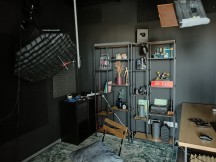Oppo Reno3 Pro review

A quad-camera setup with all the essentials
Update 16.03.2020: Since we've published the review, a final update came to the phone and it was focused mainly on the camera. We've updated the camera section with the new samples and edited the text to reflect our findings including the camera improvements.
The Oppo Reno3 Pro is fully equipped with all the essentials one would ask for - a standard Quad-Bayer main camera, an ultra-wide lens, a telephoto cam, and an additional 2MP black and white sensor. The purpose of the latter isn't exactly clear but we suspect Oppo is using this one for depth information. You can't, however, shoot with it.

So the main camera consists of a 64MP sensor pixel-binning down to 16MP actual images. The pixel size is 0.8µm (1.6µm effective pixel size), the sensor size is 1/1.72" while the lens offers an f/1.8 aperture. The telephoto unit uses a 13MP sensor coupled with an f/2.4 aperture, whereas the ultra-wide cam has 8MP resolution and captures a 119.9-degree field of view.
The front duo of cameras has an unusual 44MP main sensor snapping 40MP by default while the second camera is just there for depth sensing. This should, in theory, help produce better portrait selfies.
Camera menus
The default camera app is familiar but doesn't seem to have that many features. The essentials, aside from the standard Photo mode and the Night mode, are there, though. The Pro mode gives you all the freedom to tinker with ISO, shutter speed, white balance, manual focus, and exposure. And you can do that with all three focal lengths too.
The additional camera settings can be found in the hamburger menu in the upper-right corner giving you control over video resolution, AI Scene recognition, gestures, etc.
Daylight samples
The daylight samples all look really good. In fact, we are particularly impressed with the dynamic range the main camera offers, and it's good enough to challenge even top-tier smartphones. Colors are punchy, yet relatively accurate instead of being overly-saturated. Detail is excellent, noise is virtually non-existent and contrast is great. There's some edge softness in all of the photos but it's not something you should worry about.
Overall, the photos are looking great and if you only check out your photos on the phone's screen, you'd be delighted with the results. The wide dynamic range really makes these shots.
The ultra-wide camera is also capable of capturing some good daylight stills. Naturally, the level of detail is considerably lower compared to the primary camera, but the rendition seems similar even though the dynamic range is just a tad less impressive and colors are way more saturated. This type of processing may seem more appealing to most users with the lively colors. This camera also provides superb geometric lens correction.





Ultra-wide camera daylight samples
It's apparent that Oppo has tried to maintain consistency with all of its cameras in terms of overall rendition so you'd get similar looks from the telephoto, ultra-wide and normal cameras. The telephoto camera offers good amount of detail, sharpness, nice contrast and punchy colors, and excellent dynamic range - although still just a little less impressive compared to the main unit. And as we've noticed with previously reviewed Realme smartphones, the telephoto camera outputs 12MP images instead of the advertised 13MP.






Telephoto camera daylight samples
Low-light samples
To be honest, the nighttime pictures aren't the best ones we've seen. The performance isn't very consistent, we often got blurry photos, the ones that are okay are a bit on the soft side, and there are visible noise patches. Uneven sharpness, mainly in the poorly-lit sections, is another issue we've noticed, perhaps due to imperfect image stacking. The dynamic range, on the other hand, seemed adequate and gave us a good reason to recommend against using the Night mode.
The Night mode adds oversharpening halos to the scene and makes the photos look softer in general. Worst of all, it looks as if the software has taken several low-resolution photos, the image stacking algorithm used them for the final image, and then they were upscaled to 16MP. There are traces of upscaling on straight lines, and the detail is far from the level of the regular photos. The only things you stand to gain from using the Night mode are the punchier colors and the restored shadows but we aren't sure if the trade-off is worth it.






Main camera Night mode samples
There's also the Ultra Night mode that triggers automatically when the software detects exceptionally dark environments. Generally, photos look a bit softer than usual but it does make a difference in extremely low environments. Here are a couple of samples.
Additionally, the software offers a Tripod Night mode that works with even longer exposures if you have a tripod with you.



Main camera Ultra Night mode samples
Our stance on using the Night mode, however, takes a 180-degree turn when we talk about the ultra-wide camera. As you can see for yourself, the normal photos by the ultra-wide are soft, overexposed and noisy - downright unusable. But when you turn on the Night mode, the stills look as if they are taken with a completely different camera. There's a lot more sharpness, higher amount of detail in the shadows and highlights and contrast seems to be way better.






Ultra-wide camera low-light samples: Normal • Night mode • Normal • Night mode • Normal • Night mode
Finally, we get to the telephoto camera. Unless it's really dark, the software will opt for using the real telephoto camera - kudos for that. The processing is quite similar to the main camera, and we have the same complaints about the telephoto. General softness and noisy patches although the amount of resolved detail is okay for a telephoto camera in the dark. The Night mode will make matters worse as it will soften the images further, although it restores some shadows here and there.






Telephoto camera low-light samples: Normal • Night mode • Normal • Night mode • Normal • Night mode
And here's an example of a cropped out 2x zoom with and without Night mode.


Cropped out 2x zoom from the main camera
You can head off to our photo compare tool to do some more pixel peeping and compare the Oppo Reno3 Pro performance to every other smartphone we've tested.



Oppo Reno3 Pro against the Realme X2 Pro and Redmi K20 Pro in our Photo compare tool
Selfies
Despite being 44MP camera, the camera app defaults to 40MP resolution for selfies unless you specifically activate the 44MP mode toggle in the viewfinder.
Surprisingly, we couldn't spot any significant differences between the 40MP and 44MP photos. Both look pretty sharp if you hit the sweet spot of the camera's fixed focus distance. You can also expect natural skin tone, punchy colors and wide dynamic range. However, the latter seems to be an issue with the portrait selfies. Which, by the way, don't appear to have stellar edge detection despite the secondary depth-sensing camera. It seems like the software could have done the job without the help of a depth-sensing camera and thus making the punch-hole smaller on the front.






Selfie samples: Normal • Portrait • Normal • Portrait • Normal • Portrait




Selfie samples: 40MP • 44MP • 40MP • 44MP
There's also a selfie Night mode that appears to be more than adequate. It softens the selfies a little but can take photos in quite dim conditions - including extremely dark rooms. It does a really good job of bringing out details from the shadows. The first two photos are under dim lighting and the last two are in a really dark room.




Selfie Night mode: Normal • Night mode • Normal • Night mode
Portraits
The edge detection isn't stellar but you do get good dynamic range, nice contrast, natural-looking skin and a good amount of detail. You can see some of the mistakes the algorithm made with stills with more challenging background but in other situations, the bokeh-like effect is looking pretty good.
Video recording
The handset is capable of recording up to 2160p@30fps videos and up to 720@240fps slow-motion videos. Of course, there is some EIS going on if you go for 1080p@30fps videos but 4K lacks one. Instead, Oppo is offering the Ultra Steady and Ultra Steady Pro video modes for gimbal-like stabilization but we will talk more about that later.
Now, let's take a look at the 4K recording. Colors may look a bit desaturated at first, but they are also closer to real-life. Sharpness is really good, except for the edge softness on the left. There's also some noise in uniform areas. Contrast and dynamic range, on the other hand, are good.
The 1080p video processing is similar but the noise is slightly more apparent.
Video recording using the telephoto and the ultra-wide cameras isn't an option but by tapping on the 2x zoom button, you will be recording a cropped out clip from the main camera in 4K resolution. And the end, the result isn't bad too. Expect the exact same processing as above.
As far as stabilization goes, we already pointed out that EIS doesn't work in 2160p mode as you can see for yourself.
Tapping on the Ultra Steady icon will significantly narrow the field of view because there's some extreme cropping at play here to reduce the shakiness by cutting out the excess from all sides. The Ultra Steady video is recorded using the main 64MP camera and the result is pretty impressive. Aside from the loss in detail, which is something you'd expect, the video looks very good.
There's also a small toggle in the lower-left corner of the viewfinder, which switches to Ultra Steady Pro. You will immediately notice the wider field of view and the different processing - colors are punchier and the contrast is a bit higher. That's because the phone uses the ultra-wide camera for the Ultra Steady Pro mode. Stabilization isn't as good but you may find it more appropriate if you don't need extreme stabilization. Oh, and both Ultra Steady modes are capped at 1080p quality.
And here's a handy tool to compare the phone's video recording quality against the competition.



2160p: Oppo Reno3 Pro against the Realme X2 Pro and the Redmi K20 Pro in our Video compare tool
Reader comments
- KULDEEP
- 08 Jan 2025
- XQc
NO
- Abdullah
- 15 Sep 2024
- 2Ad
I am use this phone before 5 years It is the best phone
- Anonymous
- 13 Apr 2023
- CbG
Oppo reno 3 pro
























